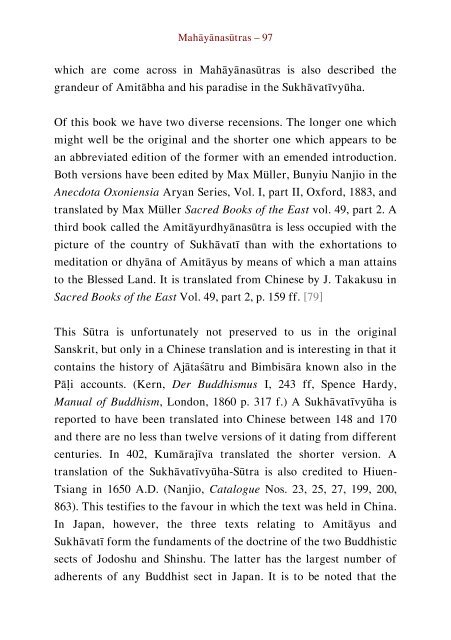Literary History of Sanskrit Buddhism
A study by J. K. Nariman of Sanskrit Buddhism from the Early Buddhist Tradition up to the Mahayana texts proper.
A study by J. K. Nariman of Sanskrit Buddhism from the Early Buddhist Tradition up to the Mahayana texts proper.
You also want an ePaper? Increase the reach of your titles
YUMPU automatically turns print PDFs into web optimized ePapers that Google loves.
Mahāyānasūtras – 97<br />
which are come across in Mahāyānasūtras is also described the<br />
grandeur <strong>of</strong> Amitābha and his paradise in the Sukhāvatīvyūha.<br />
Of this book we have two diverse recensions. The longer one which<br />
might well be the original and the shorter one which appears to be<br />
an abbreviated edition <strong>of</strong> the former with an emended introduction.<br />
Both versions have been edited by Max Müller, Bunyiu Nanjio in the<br />
Anecdota Oxoniensia Aryan Series, Vol. I, part II, Oxford, 1883, and<br />
translated by Max Müller Sacred Books <strong>of</strong> the East vol. 49, part 2. A<br />
third book called the Amitāyurdhyānasūtra is less occupied with the<br />
picture <strong>of</strong> the country <strong>of</strong> Sukhāvatī than with the exhortations to<br />
meditation or dhyāna <strong>of</strong> Amitāyus by means <strong>of</strong> which a man attains<br />
to the Blessed Land. It is translated from Chinese by J. Takakusu in<br />
Sacred Books <strong>of</strong> the East Vol. 49, part 2, p. 159 ff. [79]<br />
This Sūtra is unfortunately not preserved to us in the original<br />
<strong>Sanskrit</strong>, but only in a Chinese translation and is interesting in that it<br />
contains the history <strong>of</strong> Ajātaśātru and Bimbisāra known also in the<br />
Pāḷi accounts. (Kern, Der <strong>Buddhism</strong>us I, 243 ff, Spence Hardy,<br />
Manual <strong>of</strong> <strong>Buddhism</strong>, London, 1860 p. 317 f.) A Sukhāvatīvyūha is<br />
reported to have been translated into Chinese between 148 and 170<br />
and there are no less than twelve versions <strong>of</strong> it dating from different<br />
centuries. In 402, Kumārajīva translated the shorter version. A<br />
translation <strong>of</strong> the Sukhāvatīvyūha-Sūtra is also credited to Hiuen-<br />
Tsiang in 1650 A.D. (Nanjio, Catalogue Nos. 23, 25, 27, 199, 200,<br />
863). This testifies to the favour in which the text was held in China.<br />
In Japan, however, the three texts relating to Amitāyus and<br />
Sukhāvatī form the fundaments <strong>of</strong> the doctrine <strong>of</strong> the two Buddhistic<br />
sects <strong>of</strong> Jodoshu and Shinshu. The latter has the largest number <strong>of</strong><br />
adherents <strong>of</strong> any Buddhist sect in Japan. It is to be noted that the


















